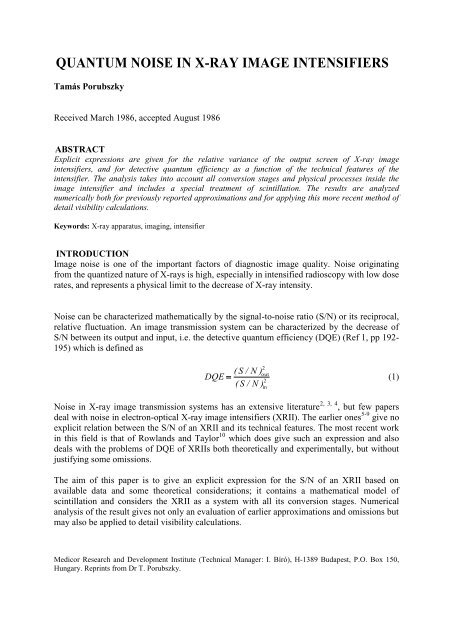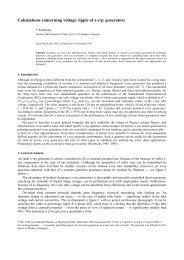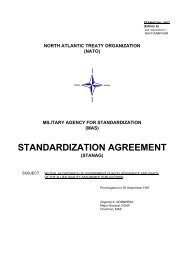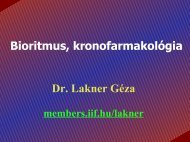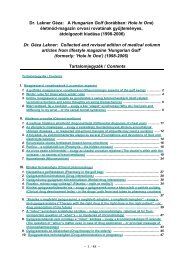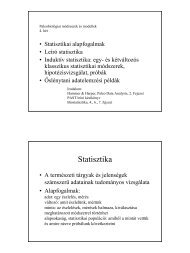QUANTUM NOISE IN X-RAY IMAGE INTENSIFIERS
QUANTUM NOISE IN X-RAY IMAGE INTENSIFIERS
QUANTUM NOISE IN X-RAY IMAGE INTENSIFIERS
- No tags were found...
You also want an ePaper? Increase the reach of your titles
YUMPU automatically turns print PDFs into web optimized ePapers that Google loves.
<strong>QUANTUM</strong> <strong>NOISE</strong> <strong>IN</strong> X-<strong>RAY</strong> <strong>IMAGE</strong> <strong>IN</strong>TENSIFIERSTamás PorubszkyReceived March 1986, accepted August 1986ABSTRACTExplicit expressions are given for the relative variance of the output screen of X-ray imageintensifiers, and for detective quantum efficiency as a function of the technical features of theintensifier. The analysis takes into account all conversion stages and physical processes inside theimage intensifier and includes a special treatment of scintillation. The results are analyzednumerically both for previously reported approximations and for applying this more recent method ofdetail visibility calculations.Keywords: X-ray apparatus, imaging, intensifier<strong>IN</strong>TRODUCTIONImage noise is one of the important factors of diagnostic image quality. Noise originatingfrom the quantized nature of X-rays is high, especially in intensified radioscopy with low doserates, and represents a physical limit to the decrease of X-ray intensity.Noise can be characterized mathematically by the signal-to-noise ratio (S/N) or its reciprocal,relative fluctuation. An image transmission system can be characterized by the decrease ofS/N between its output and input, i.e. the detective quantum efficiency (DQE) (Ref 1, pp 192-195) which is defined as( S / N )DQE (1)( S / N )2out2inNoise in X-ray image transmission systems has an extensive literature 2, 3, 4 , but few papersdeal with noise in electron-optical X-ray image intensifiers (XRII). The earlier ones 5-9 give noexplicit relation between the S/N of an XRII and its technical features. The most recent workin this field is that of Rowlands and Taylor 10 which does give such an expression and alsodeals with the problems of DQE of XRIIs both theoretically and experimentally, but withoutjustifying some omissions.The aim of this paper is to give an explicit expression for the S/N of an XRII based onavailable data and some theoretical considerations; it contains a mathematical model ofscintillation and considers the XRII as a system with all its conversion stages. Numericalanalysis of the result gives not only an evaluation of earlier approximations and omissions butmay also be applied to detail visibility calculations.Medicor Research and Development Institute (Technical Manager: I. Bíró), H-1389 Budapest, P.O. Box 150,Hungary. Reprints from Dr T. Porubszky.
Definition of the systemThe XRII may be considered as a (coherent) system, the input signal is therefore an X-raybeam incident upon the entrance window of the XRII, and the output signal is the visible light(photons) emitted by the output screen. We intend to characterize the DQE of the XRII as atransmission system by taking into account all its physical processes.The incident beamIn contrast to Rimkus and Baily 13 , but in accordance with all other authors, we start from thePoisson distribution of X-ray photons emitted from the X-ray tube 3 . On average n aphotons fall onto an area a during a time interval from an X-ray beam characterized by a2fluence rate . Because of the Poisson distribution the variance of n is n , i.e. itsstandard deviation is 1/ 2 Absorption and transmissionnnAbsorption has several times been shown to be responsible for effects between the X-ray tubeand the output screen of the XRII (X-ray tube window, window of the tube housing,collimator, filter, air, patient, radiographic tabletop, entrance window of the XRII, phosphorsubstrate, and at last the input screen itself). If exactly n 0 particles fall onto an absorbing layerand for each particle there is a probability p that it will be absorbed (and (1-p) to betransmitted) then the probability of absorption of n 1 particles is given by a Bernoulli2distribution. Its expected value is n 1 = n 0 p and its variance n p 1 p . If n 0 = 1 itfollows that for the k 1 th ‘multiplication factor’ of the process: n102k1 p ; p(1 p)(3)Changing the meaning of p and (1-p), the same can be said about the distribution of thetransmitted particles.2If the distribution of the incident particle beam is Poissonian (thereforen n00) then thedistribution of the transmitted (as well as the absorbed) particles remains Poissonian, 1,3,9,18,19with an expected value n1 n0p . The expression of the variance also can be obtainedimmediately by substituting equation 3 into equation 2. Thus the distribution of the X-rayphotons incident upon the entrance window and also of those absorbed by the input screen isPoissonian.k1nTransmission of the entrance window of the XRIILet n0 adenote the expected value of the number of X-ray photons arriving at an area aof the entrance window during a time interval , where is the fluence rate, furthermore, t isthe fraction transmitted by both this window and the phosphor substrate, i.e. t means theirtotal transmission. Then according to the foregoing, the distribution of the transmitted photonsis Poissonian, with an expected value n1 n0t. In other words: the probability of transmissionis t for each photon, thus the expected value of the k1th ‘multiplication factor’ is just k1 t .
2The variance also can be obtained indirectly by applying equation 2, substituting n n0,2k1 t and k t(1 t):n2n1121 0011 1t 1 n t n tThis expression, however, for incident particles having a Poissonian distribution, is moreeasily obtained directly.0Absorption of the input screen. K-escapeIf a fraction f of the photons incident upon the input screen is absorbed, it follows that theabsorbed photons have a Poissonian distribution with an expected value n 2n0tf , whichmay be written as k2 f (multiplication factor).K-escape fraction from the phosphor is an important factor in the decrease of S/N ratio 10 .Denoting this fraction with f , energy of a fraction f f of the particles takes partKesce1K escin the succeeding processes. Similarly, it can be considered as a ‘multiplication’ process witha ‘multiplication factor’ k3 fe, i.e. the number of particles (still having a Poissoniandistribution) which take part in the succeeding processes:n 3n0t f f (4)eModelling of scintillation2Authors generally treat scintillation as a particle multiplication process for which kkwhere k is the multiplication factor 5, 6, 14, 20 . We wish to give a more precise analysis, which isa modified version of an earlier calculation 12 modified by physical considerations.Of the X-ray interaction processes only photoeffect has a high probability in the phosphor. AnX-ray photon absorbed in a photoeffect produces a photoelectron, the energy of which isexpended totally in excitations of electron-hole pairs 21 . The energy needed for one electronholepair excitation is equal to about three times the forbidden energy bandgap 22 . Denotingthis energy by Egand the energy of an X-ray photon with E1 , one photon produces/ excitations. (It can reasonably be assumed that E 1 /E g is an integer). As E g can beE 1E gconsidered a constant, it follows from the conservation of energy that the number ofexcitations is also strictly determined. In case of n 3 absorbed photons there will beN ( E / E ) excitations. But the number of the emitted light photons will be fewer4 1 gn3than N4because radiationless transitions are also produced in the phosphor. Thedifference between absorbed energy and emitted light energy is converted into heat.The energy emitted in the form of light photons can be obtained with the aid of the energytransformation efficiency (or scintillation efficiency) . In case of absorption of one X-rayphoton having an energy E1the total emitted light energy will be E2 E 1
whence the expected number of light photons of energy E 2 is E / E E/ . In the2 2 1E2case of absorption of n3X-ray photons the expected number of light photons will ben4 n3E1/ E2 . The number of light photons emitted by individual events fluctuatesaround the mean value E 1/ E 2 .The probability that a light photon will arise from an excitation, is therefore: p1 n4/ N4. Forthe ‘multiplication factor’ of the excitation-light photon transition: k4 p1and2k p11 p1. Hence the variance of the number of light photons (in case of n4 3absorbedX-ray photons): .2n N4p11p4 1The multiplication factor of the whole scintillation processes k5 n4/ n3where n3is given byequation 4. Hence n4 k5n3; on the other hand n4 p1N4. Thus the corresponding term tobe substituted into equation (2) is:2It follows that k 1 p 2 2n 11111114 n p p p p31 2 22n4n3N4p1N4p1k5n. (5)3 2k55 1. Those authors who have taken55k k , overestimated thevariance (Poisson limit). As we shall see later, this difference causes only a very small (somethousandths) difference in the DQE of an XRII. (The same can be said of scintillationcounters). The model which has just been outlined is felt to be physically better founded and italso shows the permissibility of the usual approximations.The photocathodeThe efficiency of light collection is very close to 1 even in ordinary scintillation counters. Forthe input screen of an XRII, consisting of CsI needle crystals which function as lightconductors and have practically no self-absorption, it certainly can be taken as 1. Thereforethere is no statistical noise increase in this stage.Photons emitted from the input screen produce electron emission from the photocathode. Onephoton can only remove one electron or none. (As even photons of the smallest energy in therelatively narrow scintillation spectrum can induce photoeffect, this spectrum has no influenceon the fluctuation of the number of photoelectrons.) The probability of electron emission isgiven by the quantum efficiency . Thus this process can be treated in a similar mathematicalmanner to absorption. The 'multiplication factor' of the process:2k k1. (6)6As the distribution of the incident light photons, then differ from the Poissonian, the result ofsubstituting equation 6 into equation 2 cannot be reached by simple considerations; sincen5 n 4 , the corresponding term in equation 2 will be6
2nn5252n42n411 n n t f f k 40e5The efficiency of electron collection onto the output screen, however, is smaller than 1because of back- scattering. Let denote this efficiency. Repeating the former considerations,the (noise-equivalent) number of electrons absorbed in the output screen can be given byn6 n 5 , furthermore, for the ‘multiplication factor’ k7of the process:2k ; 17k.7Thus the coriesponding term in equation 2 will be2nn6262n52n51n 5The output screenThe expected number of light photons emitted from the output screen will be n7 k8n6wheren6the expected value of absorbed electrons and k8is the expected value of the correspondingmultiplication factor. ThereforeXRII <strong>NOISE</strong> AND DQEn2n727 n2n6261pk n862Taking into account the former results, the relative variance of the number of light photonsemitted by the output screen of an XRII can be given by the following explicit expression(performing the possible reductions):n2n7271n t f0fe 1p1 k51111p2 k k k k5558 n01, (7) DQE2where equation 1 and n n0 0were taken into account. Denoting the parts in brackets by B, itcan be written that DQE of the XRII is:DQE 1t f fe B(8)In equation 7: n7 n0tffek5 k8is the expected number of output photons during a timeinterval corresponding to an area a of the input screen,n a0
where φ is the fluence rate of the X-ray beam incident upon the entrance window of the XRII,t the total transmission of the entrance window and the phosphor substrate,f the fraction of X-ray photons absorbed in the input screen,fethe fraction of the absorbed photons remaining after K-escape,k5and k8are the multiplication factors of the input and the output screen,p1and p2are the probabilities of luminous transitions of excitations in the input and theoutput screen is the quantum efficiency of the photocathode and the (noise-equivalent) efficiency of electron collection to the output screen. (Dimensions:2 1[ ] m s ,2[ a] m , [ ] s, all the other quantities in equation 7 are dimensionless.)Notes.(i) With direct application of equation 2:n2n7271 1t1fn10 t tf1ft f feeB.It can be seen that this expression equals [ n0tffequation 7.e1 B ], corresponding therefore to(ii) As Rowlands and Taylor 10 point out, the value of the DQE depends upon the spatial andthe temporal frequency. All investigations carried out so far (including the present work)consider DQE only for very low spatial and temporal frequencies.(iii) If the light collection efficiency (from the input screen to the photocathode) is 1, thenin B of equations (7) and (8) a new term appears as follows:1pB 1k5 p2 k k k k k11 11155558but when 1 its influence remains negligible.
Detail visibilityFor an X-ray beam having a given (mean) quantum energy and for given XRII features,taking as the storage time of the human eye (radioscopy), the output S/N ratio can be writtenasS / Nnn71 2 7 Y a(9)where Y is a numerical constant. In order to be visible in the presence of fluctuation a givenpattern must have a contrast of at leastkC , (10)S / Nwhere the value of k lies between 3 and 5 (Refs 4 and 11). In equation 10 C is the image1contrast. a 2in equation (9) corresponds to the linear dimension h of the pattern. Fromequation (9) and (10):kC . (11)Y h 1/ 2Equation 11 is a general relation between C , h and (for given Y and k) from which one cancalculate the minimum needed to make a pattern visible with a given h and C, or thesmallest visible detail diameter for given and C. This limiting resolution, obviously,expresses the limiting role of quantum noise alone. Therefore other properties of the imagetransmission system must also be considered. (Limiting resolution from contrast transfer —expressed usually with modulation transfer functions — cannot be exceeded.)Numerical calculation of DQE valuesLet us apply the previous results for the so-called III, IV and IVE generation of XRIIs madeby Thomson-CSF (France). Most of the data are taken from the work of Driard et al. 8 andother Thomson product guides. The data used and the calculated values are shown in Table 1,the following must be added to it:The radiation of a 7 mm aluminium half value layer for which the X-ray absorption of theinput screen is given, corresponds to U = 74.7 kV X-ray tube voltage and x = 22 mm Al totalfiltration according to Mika and Reiss 23 . The calculated mean energy weighted by fluence forthese parameters is E = 53.9 keV (Ref. 24). Thus the approximation E1= 54 keV for theabsorbed photons is reasonable. The excitation energy of electron-hole pairs in a CsI input screencan be estimated as E = 20eV (Ref. 22). From these data the number of excitationsgoriginating from absorption of an X-ray photon is N / n E / E 2700 . On the other hand,4 3 1 gas the energy conversion efficiency is = 0.08 and energy of an emitted light photon is E2=
3 eV (Ref. 8), their number: k n / n E/ E 14405 4 3 1 21n4/ N41440/ 2700 0.photon emitting transition: p 533 .. Hence the probability of aTable 1Some calculated image intensifier parametersGeneration III IV IVESource data t 0.75 a 0.75 0.85f (54 keV) 0.60 0.75 0.78B -1 0.99 0.99 0.99DQE (60 keV) 0.34 0.44 0.52Fitted f e 0.91 0.91 0.91Calculated d/μm 191 289 315DQE (54 keV) 0.41 0.51 0.60f (60 keV) 0.50 0.65 0.68a estimated valuet total transmission fraction of the entrance window and phosphor substratef fraction absorbed in the input screenf e remaining fraction after K-escaped thickness of the input screen (for 100% density)DQE detective quantum efficiencyB see equations (7) and (8) of the textQuantum efficiency of the photocathode can be taken as = 0.15 (Ref. 8) while the efficiencyof the electron collection is about = 0.75 (Ref. 10). As k8 10 3 , the last term in B is smallerthan the others by some orders of magnitude, there is no significance in the value of p 2 .From these data one can obtain B -1 = 0.993, independently of generation (to three digits).The assumed thicknesses of the input screen d were calculated fromf d1 e ,where /ρ is the mass attenuation coefficient and ρ is the density of CsI. The value of /ρ wascalculated from /ρ values of Cs and I by weighting by fraction by weight and making a linearinterpolation on a log-log scale between the tabulated values of Plechaty et al. 25 The densityof the needle crystals was assumed to be 100%, i.e. ρ = 4.5 g cm -3 . Using the thicknesses dcalculated from the data of absorption at 54 keV, the value of f can be calculated for anyenergy. As values of DQE are usually given for 60 keV, we attempted to complete the dataseries for these two values (i.e. 54 and 60 keV).The value of f e was subsequently chosen in order to be compatible with the other results.
Numerical examples for detail visibility calculationsFor U = 74.7 kV constant X-ray tube voltage, 2 mm Al equivalent inherent filtration and 25cm water phantom (which corresponds to a large patient) the mean X-ray beam energy:E 1 = 54 keV. Then for i = 1.5 mA tube current the fluence: = 4.8 10 5 cm -2 s -1 (Ref. 24). Inthis case quantum noise is clearly visible. Substituting the previous numerical values inequation 7 (for IVE generation):n7 1n71.29n 1/ 20, (12)i.e. the fluctuation of the output is 1.29 times greater than that of the input beam. (For III andIV generation this factor is 1.56 and 1.40, respectively.)Taking = 0.2 s, from eq. (12):n7 S/N 0.78 n 1/ 2 1/ 2 1/ 20 0.78 a 0. 35 a. (13)n7Substituting = 4.8 10 5 cm -2 s -1 and then substituting equation 13 into 11, for a contrastC = 5% (in this case S/N ratio = 100 is needed), the smallest perceptible size: h = (a) l/2 = 0.42cm. Therefore the limiting resolution originating from quantum noise is 1.1 lp/cm.For a contrast of 10% this would be 2.2 lp/cm.Increasing the X-ray tube current to i = 6 mA, fluence will be proportional, i.e. = 1.9 10 6cm -2 s -1 . Then for the same contrast values the limiting resolution will be 2.4 and 4.8 lp/cm,respectively.CONCLUSIONSThe calculations show how the physical processes taking place in XRII tubes increase thenoise and at the same time prove the admissibility of some earlier unjustified omissions andapproximations.It can be seen from equation (8), taking into account that for current XRIIs B -1 1, that f e isdetermined by such physical processes as can be affected only indirectly (e.g. by increasingthe phosphor thickness). The DQE value of XRIIs can, in practice, be increased only byincreasing the transmission of the entrance window and the phosphor substrate, and increasingthe absorption of the input screen. (The thickness of the input screen is always a compromisebetween X-ray absorption and light collection efficiency.)Comparing our results (Table 1) with those of Rowlands and Taylor 10 , there is generally agood agreement. However, in our opinion, in the theoretical considerations of Rowlands andTaylor the number of light photons emitted from the input screen is overestimated, (theirestimation refers rather to the number of excitations) while the number of photoelectrons


